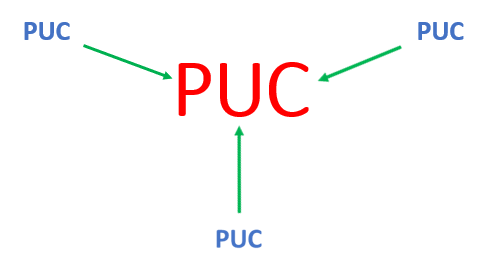Brand portfolio – New opportunities for optimization
The case: The defendant company had two national brands ‘PUC’ in Germany, dating from 1980, and a much younger European Union brand, ‘PUC’, in its brand portfolio: It tried to transfer the rights of the national trade marks to its Union trade mark.
The Union Trade Mark Regulation allows the rights of national trade marks (marked blue) to be retained in accordance with their national seniority by transferring them to an identical Union trade mark (marked red). Once an application is successful and the national trade mark is surrendered.

The Union trade mark thereby acquires the seniority of this earlier national trade mark (seniority) in case of its registration in the territory of the former national trade mark. What exactly this means and what conditions are required was decided by the European Court of Justice.
Contrary to what the German legislator and the Federal Court of Justice originally assumed, the national trade mark does not continue to exist in the seniority of the Union trade mark. After the renunciation of the national trade mark, only the Union trade mark continues to exist. It is a legal fiction that the Union trade mark has taken over all previous rights including its priority in the former country of protection. However, the national trade mark must be in legally effective use at the time of its surrender, if it has been registered for more than five years, and there must be no obstacles to its protection. Since the German Trade Mark Act assumed the continued existence of the national trade mark, and therefore stipulated different requirements for the legal validity of seniority, it violated European law.
The Court herewith upheld the author of this blog’s reasoning in this case. The findings of the Court have far-reaching implications. As there is now only one Union trade mark, this alone needs to be managed and renewed. This saves both internal and external costs. Moreover, the trade mark owner can maintain the valuable rights of their national trade marks in the respective countries solely by using the Union trade mark, even if the Union trade mark has only just been registered. For example, the old rights of Portuguese, Spanish and French trade marks could be maintained by using a just-registered Union trade mark in an online shop in Bulgaria. Contrary to the opinion of the German Federal Court of Justice and the German trade mark legislator, use in Portugal, Spain and France is no longer necessary to maintain the valuable protection in these countries. Under certain circumstances, a relocation of the use of the Union trade mark to countries in the EU with low-cost and fiscally attractive conditions may now also be worth considering. In international infringement proceedings, the time-consuming and expensive compilation of country-specific use documents is no longer necessary. Court proceedings will thus become cheaper and more calculable, Court of Justice of the European Union, C-148/17, judgment of 19.04.2018 and BGH – PUC II, judgment of 08.11.2018.
Learnings: The ruling provides more security and stability to the overall protection of the goodwill of a company in the European Union, for less money. You can now take advantage of the opportunities arising from the concept of seniority. However, the brand portfolio must be analysed in advance of any restructuring to determine whether all the legal requirements for realising these benefits are met and whether the restructuring makes economic sense.